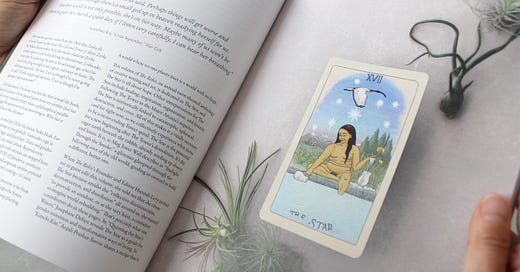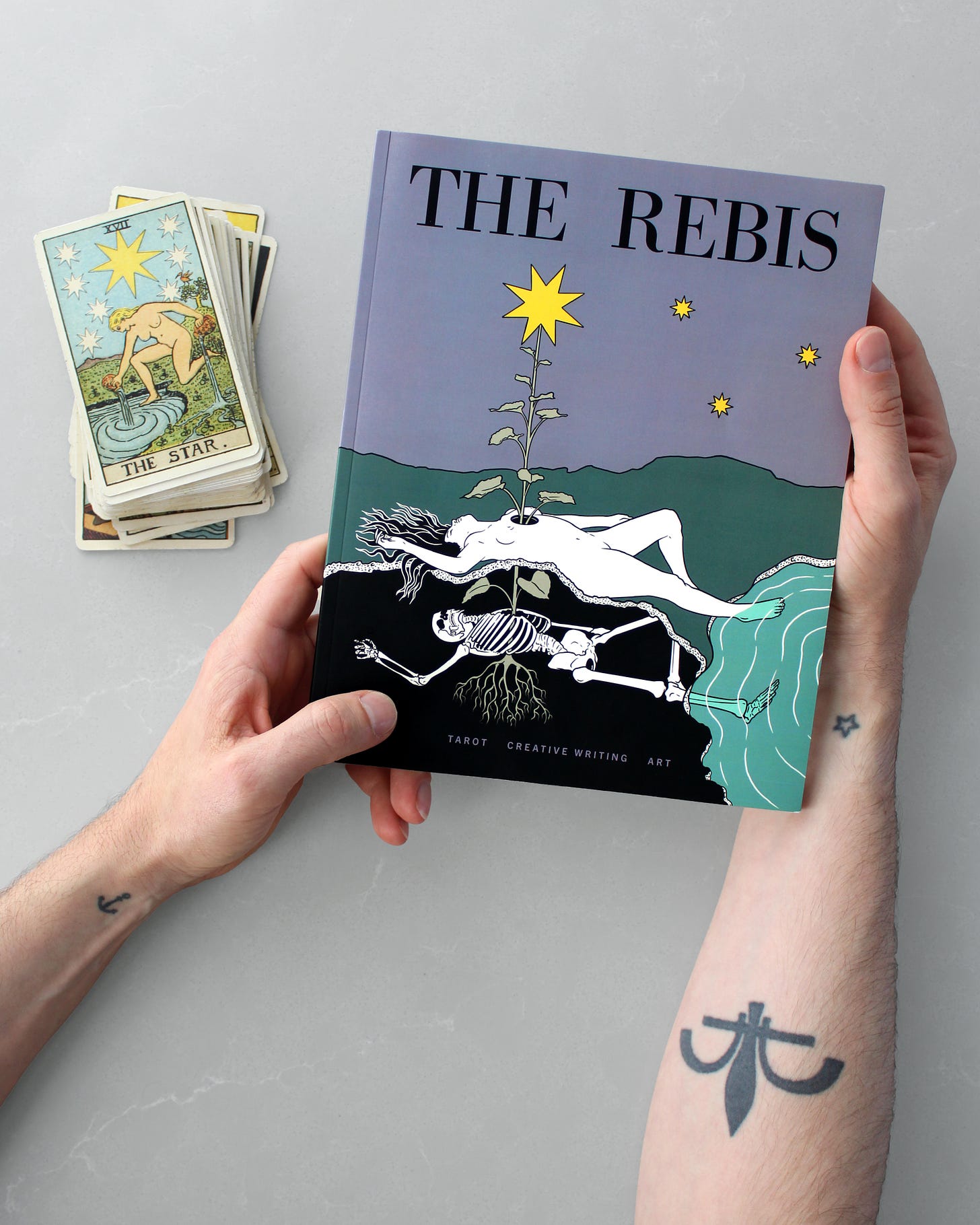Today we are publishing the editor’s note from The Rebis, Volume 3: The Star, written by our guest editor, . Our new print issue features more than 30 writers and artists exploring themes of The Star. Preorders are currently open and the publication will ship out in mid-October. You’ll get a beautiful full-color 8x10 book with 114 pages of fiction, essays, poetry, interviews, creative non-fiction, and original artwork. We redistribute all profits to social justice orgs.
Star Fruits
Introducing The Rebis, Volume 3: The Star
by
“The time has come, the Walrus said. Perhaps things will get worse and then better. Perhaps there’s a small god up in heaven readying herself for us. Another world is not only possible, she’s on her way. Maybe many of us won’t be here to greet her, but on a quiet day, if I listen very carefully, I can hear her breathing.”
—Arundhati Roy, “Come September,” War Talk
My mother quotes a scene from the 1964 film Zorba the Greek, based on the novel The Life and Times of Alexis Zorba by Nikos Kazantzakis. In it, the titular character Zorba comes upon an old man planting an almond tree. Zorba asks him why he’s planting the tree at his advanced age, when he won’t live long enough to see it grow and enjoy its fruits. The old man responds, “My boy, I act as though I’m never going to die!” Zorba laughs and declares, “I act as though I’m going to die tomorrow!”
Full disclosure, I’ve never watched the film or read the book, but it’s a piece of lore passed down from my mother that has stuck in my mind for thirty years, a philosophical parable that begs the question without answering it: Who has it right? Zorba or the old man?
As I write this in mid-July 2024, the future looks bleak. Far-right politics continues to rise globally. Genocides rage in Palestine, Sudan, Congo, and elsewhere. Trans and gender-nonconforming people are under attack. Reproductive rights for women and people with uteruses are stripped bare. The lethal and disabling COVID-19 pandemic continues unabated while governments and corporate entities pretend it’s just a cold. And climate crisis isn’t coming—it’s here.
This is Zorba’s world, a world where tomorrow is far from guaranteed. So what do we do? Do we forget the future and make the most of the present? Do we stop planting almond trees?
A world where no one plants trees is a world with no hope.
This volume of The Rebis, an annual tarot-themed anthology of creative writing and art, is dedicated to The Star, and The Star is all about hope. Other interpretations for The Star include healing, inspiration, regeneration, and futurity. Following The Tower in the Major Arcana’s sequence, The Star is intrinsically linked to catastrophe, upheaval, destruction, and crisis. All of this makes it a vitally necessary card for right now, as we collectively experience what seems to be a never-ending Tower spiral. The Star is the potential for a new beginning after The Tower’s demolition. It’s the eager earth beneath the rubble, already sending up shoots and leaves. It is, as Meg Jones Wall describes in “Starlight Through the Smoke,” a glimmer glimpsed through the billowing soot of the old world, guiding us onward to build a different, better one.
When The Rebis’s founder and editor
invited me to guest edit this volume, she told me that she chose The Star because amidst the “collective disconnection, deconstruction, and dissolution” all around us, she wanted “to provide an antidote, or at the very least, a container to imagine world rebuilding.”The worlds built in these pages are fluid, buzzing, transitional, and transformative, each one a potential model, a seed, for other ways of living beyond these crumbling Tower walls.
That’s precisely what our contributors do in these pages. In “Queering the Star’s Waters,” Josephine Defaye reveals The Star as a guide for gender transition and transformative ways of living. In “Kimchi Kin,” Anjali Prashar-Savoie shares a recipe that is also an exercise in building alternative relationship structures outside the cis-hetero nuclear family model. Lane Smith takes us on a journey into a strangely familiar underwater world in “We Are Many,” revisiting an old fable for a new world, while Tehlor Kay Mejia’s “Tell Them” and Rebecca Scolnick’s “The Pool” offer fertile speculative visions of the future after the end of the world as we know it. The worlds built in these pages are fluid, buzzing, transitional, and transformative, each one a potential model, a seed, for other ways of living beyond these crumbling Tower walls.
In such a fraught present, the stories, poems, comics, essays, and art in this volume stand as a material proof of hope. These pages are rich with tales of hope amidst grief, liberation through crisis, and healing in unexpected places. Raena Zupan opens our volume with “Rising Star,” taking us on an unconventional healing journey in the unlikeliest of places. In “Starlight in My Bones,” Eli Lawliet offers a powerful personal story of leaving an abusive relationship and building himself a true home in his body. Elizabeth Marian Charles shares a personal narrative of a harrowing loss, a vengeful underworld goddess, and the twisting path of healing in “The Living and Dead Carry On.” Clare Edge’s short fiction, “The Star of the Journey™ (Fuck Hope),” humorously skewers the wellness industry while revealing the paradoxical healing of giving up on cures, while in “A Body that Ripples,” KJ Naum describes how queer yoga helps them dismantle systems of oppression through embodiment. Four pieces from Coleman Stevenson pair artwork and prose poetry to create multimedia vignettes of (re)building a life.
In such a fraught present, the stories, poems, comics, essays, and art in this volume stand as a material proof of hope.
The Star can be very abstract and cerebral, so Hannah and I frequently talked about “bringing The Star down to Earth.” I believe we’ve achieved that—or, I should say, the contributors have—offering embodied healing practices, fertile inspiration for future-dreaming, practical actions for change, and tangible bases for hope. An active journaling ritual from Stephanie Adams-Santos and Anna Barouh Davis guides us on an exploration of our inner night sky. Kristin Mathis and Lex Hesperus discuss stars as ancestors in an ancient mystery tradition, capped with a new translation of an ancient prayer that can be used in one’s modern spiritual practice. An interview with Elicia Epstein, the curator and organizer of Liberation Tarot, and Sarah Rosenblatt, the artist behind The Star for the deck, gives a glimpse into collaborative art-making and revolutionary dreaming with tarot.
We are honored to have 30 contributors in this volume, more than I can individually remark on here. But trust me when I say that these works are the living evidence of The Star’s renewal, the material proof of hope. They have been transmuted from grief, trauma, and devastation into beauty and inspiration. Like Creative Director Xaviera López’s gorgeous illustration for the cover of this issue, these stories have sprouted from ashes, grown through bones, and fruit toward Stars. If that’s not grounds for hope, I don’t know what is.
In the first draft of this editor’s note, I mistakenly wrote the almond tree in Zorba’s anecdote as an olive tree, the cherished tree and symbol of Palestine. Planting an olive tree, almond tree, or any tree is an intrinsically hopeful act. It’s an investment in the material present for an unassured future where the tree isn’t bombed by war machines or bulldozed by settler-colonizers; where the tree survives wildfire and flood, drought and pestilence; where it isn’t chopped for firewood in a desperately cold and hungry winter. It’s a hopeful act in creating a potential future where that tree survives, grows, thrives, and blooms.
We make our own material conditions for hope through action, through art, through organizing, through helping one another, through rebuilding our kinship with the earth. Our challenge, individually and collectively, is to not become trapped in this Tower’s rubble by thinking there’s nowhere else—no way else—to live. Our challenge is to set our sights on better Stars and do our damndest to build different, better, more liberated ways of life together, guided by that hopeful Polaris. To plant trees in the ashes, even if we may never enjoy their fruits in our lifetime.
We make our own material conditions for hope through action, through art, through organizing, through helping one another, through rebuilding our kinship with the earth.
Maybe that’s what the old man knew that Zorba didn’t. There is a future, even if you and I and that old man are not around to see it. There is a future where our descendants eat almonds and olives in the shade of the leaves. There is a future where the trees bloom, but only if we plant them today.
May this volume plant a tree in you.
Because you, reading this, are reason enough for hope.
Guest Editor, The Rebis






Ahhh! Congratulations! This is truly exceptional.